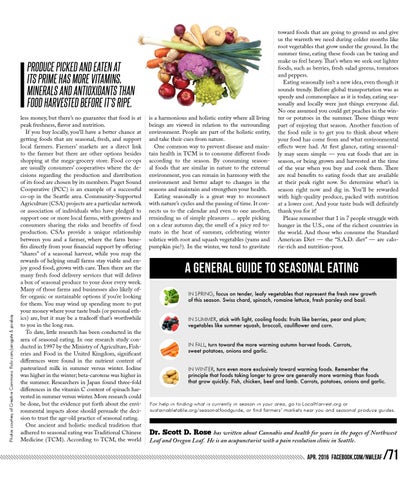Photos courtesy of Creative Commons: flickr.com/jansgate & pixabay
PRODUCE PICKED AND EATEN AT ITS PRIME HAS MORE VITAMINS, MINERALS AND ANTIOXIDANTS THAN FOOD HARVESTED BEFORE IT’S RIPE. less money, but there’s no guarantee that food is at peak freshness, flavor and nutrition. If you buy locally, you’ll have a better chance at getting foods that are seasonal, fresh, and support local farmers. Farmers’ markets are a direct link to the farmer but there are other options besides shopping at the mega-grocery store. Food co-ops are usually consumers’ cooperatives where the decisions regarding the production and distribution of its food are chosen by its members. Puget Sound Cooperative (PCC) is an example of a successful co-op in the Seattle area. Community-Supported Agriculture (CSA) projects are a particular network or association of individuals who have pledged to support one or more local farms, with growers and consumers sharing the risks and benefits of food production. CSAs provide a unique relationship between you and a farmer, where the farm benefits directly from your financial support by offering “shares” of a seasonal harvest, while you reap the rewards of helping small farms stay viable and enjoy good food, grown with care. Then there are the many fresh food delivery services that will deliver a box of seasonal produce to your door every week. Many of those farms and businesses also likely offer organic or sustainable options if you’re looking for them. You may wind up spending more to put your money where your taste buds (or personal ethics) are, but it may be a tradeoff that’s worthwhile to you in the long run. To date, little research has been conducted in the area of seasonal eating. In one research study conducted in 1997 by the Ministry of Agriculture, Fisheries and Food in the United Kingdom, significant differences were found in the nutrient content of pasteurized milk in summer versus winter. Iodine was higher in the winter; beta-carotene was higher in the summer. Researchers in Japan found three-fold differences in the vitamin C content of spinach harvested in summer versus winter. More research could be done, but the evidence put forth about the environmental impacts alone should persuade the decision to trust the age-old practice of seasonal eating. One ancient and holistic medical tradition that adhered to seasonal eating was Traditional Chinese Medicine (TCM). According to TCM, the world
is a harmonious and holistic entity where all living beings are viewed in relation to the surrounding environment. People are part of the holistic entity, and take their cues from nature. One common way to prevent disease and maintain health in TCM is to consume different foods according to the season. By consuming seasonal foods that are similar in nature to the external environment, you can remain in harmony with the environment and better adapt to changes in the seasons and maintain and strengthen your health. Eating seasonally is a great way to reconnect with nature’s cycles and the passing of time. It connects us to the calendar and even to one another, reminding us of simple pleasures ... apple picking on a clear autumn day, the smell of a juicy red tomato in the heat of summer, celebrating winter solstice with root and squash vegetables (yams and pumpkin pie?). In the winter, we tend to gravitate
toward foods that are going to ground us and give us the warmth we need during colder months like root vegetables that grow under the ground. In the summer time, eating these foods can be taxing and make us feel heavy. That’s when we seek out lighter foods, such as berries, fresh salad greens, tomatoes and peppers. Eating seasonally isn’t a new idea, even though it sounds trendy. Before global transportation was as speedy and commonplace as it is today, eating seasonally and locally were just things everyone did. No one assumed you could get peaches in the winter or potatoes in the summer. Those things were part of enjoying that season. Another function of the food mile is to get you to think about where your food has come from and what environmental effects were had. At first glance, eating seasonally may seem simple — you eat foods that are in season, or being grown and harvested at the time of the year when you buy and cook them. There are real benefits to eating foods that are available at their peak right now. So determine what’s in season right now and dig in. You’ll be rewarded with high-quality produce, packed with nutrition at a lower cost. And your taste buds will definitely thank you for it! Please remember that 1 in 7 people struggle with hunger in the U.S., one of the richest countries in the world. And those who consume the Standard American Diet — the “S.A.D. diet” — are calorie-rich and nutrition-poor.
A GENERAL GUIDE TO SEASONAL EATING IN SPRING, focus on tender, leafy vegetables that represent the fresh new growth of this season. Swiss chard, spinach, romaine lettuce, fresh parsley and basil.
IN SUMMER, stick with light, cooling foods: fruits like berries, pear and plum; vegetables like summer squash, broccoli, cauliflower and corn.
IN FALL, turn toward the more warming autumn harvest foods. Carrots, sweet potatoes, onions and garlic.
IN WINTER, turn even more exclusively toward warming foods. Remember the
principle that foods taking longer to grow are generally more warming than foods that grow quickly. Fish, chicken, beef and lamb. Carrots, potatoes, onions and garlic.
For help in finding what is currently in season in your area, go to LocalHarvest.org or sustainabletable.org/seasonalfoodguide, or find farmers’ markets near you and seasonal produce guides.
Dr. Scott D. Rose has written about Cannabis and health for years in the pages of Northwest Leaf and Oregon Leaf. He is an acupuncturist with a pain resolution clinic in Seattle.
apr. 2016 FACEBOOK.COM/NWLEAF
/71
